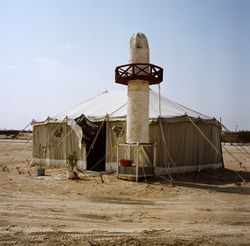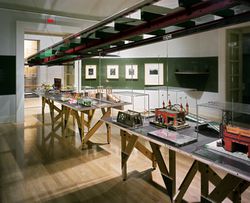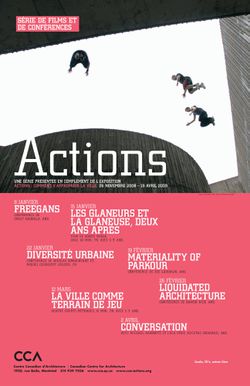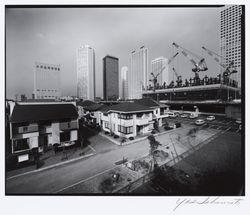Learning from... Bahrain
Noura al Sayeh presents the third lecture in the Learning From… the Middle East series. The presentation will survey the photographic documentation of the Bahrain coast by photographer Camille Zakharia. The urban transformations in the last 30 years have redrawn the Bahraini landscape and triggered the development of a contemporary vernacular culture. The presentation(...)
Paul-Desmarais Theatre
6 October 2011 , 7pm
Learning from... Bahrain
Actions:
Description:
Noura al Sayeh presents the third lecture in the Learning From… the Middle East series. The presentation will survey the photographic documentation of the Bahrain coast by photographer Camille Zakharia. The urban transformations in the last 30 years have redrawn the Bahraini landscape and triggered the development of a contemporary vernacular culture. The presentation(...)
Paul-Desmarais Theatre
Toys and Transport
Every new transportation link and every change in systems of urban mobility introduces new infrastructure to the urban landscape: massive cuts enabling railway tracks to converge at a terminal or junction; wide railyards that service suburban and metropolitan transit systems; the proliferation of bridges, ramps, elevated highways, freeway cuts, parking lots, and even(...)
Octagonal gallery
15 November 2000 to 1 April 2001
Toys and Transport
Actions:
Description:
Every new transportation link and every change in systems of urban mobility introduces new infrastructure to the urban landscape: massive cuts enabling railway tracks to converge at a terminal or junction; wide railyards that service suburban and metropolitan transit systems; the proliferation of bridges, ramps, elevated highways, freeway cuts, parking lots, and even(...)
Octagonal gallery
Materiality of Parkour
Engineer, artist, and theoretician Zoe Laughlin presents the new functions of existing materials in public spaces in relation to parkour, an activity which reinterprets the urban landscape. Her ideas focus on the materiality of daily life: how matter behaves, its sensorial qualities, and how people react to it. A member of the Division of Engineering’s Materials Research(...)
Paul Desmarais Theatre
19 February 2009
Materiality of Parkour
Actions:
Description:
Engineer, artist, and theoretician Zoe Laughlin presents the new functions of existing materials in public spaces in relation to parkour, an activity which reinterprets the urban landscape. Her ideas focus on the materiality of daily life: how matter behaves, its sensorial qualities, and how people react to it. A member of the Division of Engineering’s Materials Research(...)
Paul Desmarais Theatre
Series
Sketchbooks
AP178.S2
Description:
Series AP178.S2 consists of over 280 of Siza’s personal sketchbooks, beginning from the late 1970s to the beginning of the early 2000s. The sketchbooks mostly contain sketches with some notes and are numbered chronologically. Indicated on the front cover of each sketchbook are the sketchbook number and the architectural project(s) and/or the geographic site(s) documented by the sketches and notes. The sketchbooks are mostly black notebooks and measure 21 x 30 cm, with a few exceptions. Most sketchbooks contain notes in Portuguese while some also include French and English notes. The sketchbooks document Siza’s creative process and demonstrate his unique method to comprehend an architectural project. Siza mentions that in the early stages of a project he immediately begins to draw, regardless of if he has knowledge of all the details and problems. The sketchbooks document the evolution of Siza's projects and also serve as a type of log. Not only does each sketchbook contain various sketches and notes for projects Siza was working on but also schedules, contacts, and drafts of letters. Among the sketches for projects are also general sketches of his travels, people, animals, objects, furniture, and at times landscapes. Most sketchbooks primarily contain sketches for projects with intermingled sketches of people or faces, however there are a number of sketchbooks that mostly contain sketches of people. The Siza fonds is being processed in four phases. Up to date the sketchbooks that have been processed are ones that relate to architectural projects that were processed in the first and second phase of processing. This includes projects from 1950’s, 1960’s, and 1970’s; urban planning projects; Reconstrução do Chiado; Berlin projects submitted to the IBA competition; and the Plano de urbanização Deelgebied 5 Schilderswijk-West in The Hague. However, it is important to note that the sketchbooks usually contain sketches related to multiple projects and therefore the sketchbooks that were processed also contain sketches related to projects not included in this list.
1978-1993
Sketchbooks
Actions:
AP178.S2
Description:
Series AP178.S2 consists of over 280 of Siza’s personal sketchbooks, beginning from the late 1970s to the beginning of the early 2000s. The sketchbooks mostly contain sketches with some notes and are numbered chronologically. Indicated on the front cover of each sketchbook are the sketchbook number and the architectural project(s) and/or the geographic site(s) documented by the sketches and notes. The sketchbooks are mostly black notebooks and measure 21 x 30 cm, with a few exceptions. Most sketchbooks contain notes in Portuguese while some also include French and English notes. The sketchbooks document Siza’s creative process and demonstrate his unique method to comprehend an architectural project. Siza mentions that in the early stages of a project he immediately begins to draw, regardless of if he has knowledge of all the details and problems. The sketchbooks document the evolution of Siza's projects and also serve as a type of log. Not only does each sketchbook contain various sketches and notes for projects Siza was working on but also schedules, contacts, and drafts of letters. Among the sketches for projects are also general sketches of his travels, people, animals, objects, furniture, and at times landscapes. Most sketchbooks primarily contain sketches for projects with intermingled sketches of people or faces, however there are a number of sketchbooks that mostly contain sketches of people. The Siza fonds is being processed in four phases. Up to date the sketchbooks that have been processed are ones that relate to architectural projects that were processed in the first and second phase of processing. This includes projects from 1950’s, 1960’s, and 1970’s; urban planning projects; Reconstrução do Chiado; Berlin projects submitted to the IBA competition; and the Plano de urbanização Deelgebied 5 Schilderswijk-West in The Hague. However, it is important to note that the sketchbooks usually contain sketches related to multiple projects and therefore the sketchbooks that were processed also contain sketches related to projects not included in this list.
Series
1978-1993
archives
Level of archival description:
Fonds
Jean-Louis Cohen fonds
AP210
Synopsis:
The Jean-Louis Cohen fonds, 1968 – 2023, documents the projects and activities of historian, curator, professor, and architect Jean-Louis Cohen (1949 – 2023). Cohen’s research focus was largely modern architecture and transnational architectural exchange, particularly between and among the United States, Europe, and the former Soviet Union in the 20th century. Through physical and digital records, this fonds documents his academic, publishing, and curatorial work along with his professional activities within architectural research and heritage organizations, as well as his architectural practice.
1968 - 2023
Jean-Louis Cohen fonds
Actions:
AP210
Synopsis:
The Jean-Louis Cohen fonds, 1968 – 2023, documents the projects and activities of historian, curator, professor, and architect Jean-Louis Cohen (1949 – 2023). Cohen’s research focus was largely modern architecture and transnational architectural exchange, particularly between and among the United States, Europe, and the former Soviet Union in the 20th century. Through physical and digital records, this fonds documents his academic, publishing, and curatorial work along with his professional activities within architectural research and heritage organizations, as well as his architectural practice.
archives
Level of archival description:
Fonds
1968 - 2023
archives
Level of archival description:
Fonds
Milton Parc fonds
AP025
Synopsis:
The Milton Parc fonds, 1969 – 1989, documents the Société du patrimoine urbaine de Montréal’s (SPUM) planning, design and renovation of Montreal’s historic Milton Parc neighbourhood. Recognized as one of the largest co-operative rehabilitation projects completed in Canada, the Milton Parc housing project (1979-1982) renovated over 135 historic buildings and 597 dwelling units within Milton Parc’s 6-block radius. The fonds consists of the following materials: approximately 600 drawings, 85 l.m. of textual records, 0.6 l.m. of slides, 0.6 l.m.of photographs, 8 posters, 3 seals, 2 models, 2 rubber stamps, and 2 audio cassettes.
1962-1989
Milton Parc fonds
Actions:
AP025
Synopsis:
The Milton Parc fonds, 1969 – 1989, documents the Société du patrimoine urbaine de Montréal’s (SPUM) planning, design and renovation of Montreal’s historic Milton Parc neighbourhood. Recognized as one of the largest co-operative rehabilitation projects completed in Canada, the Milton Parc housing project (1979-1982) renovated over 135 historic buildings and 597 dwelling units within Milton Parc’s 6-block radius. The fonds consists of the following materials: approximately 600 drawings, 85 l.m. of textual records, 0.6 l.m. of slides, 0.6 l.m.of photographs, 8 posters, 3 seals, 2 models, 2 rubber stamps, and 2 audio cassettes.
archives
Level of archival description:
Fonds
1962-1989
The New Spirit: Modern Architecture in Vancouver, 1938–1963 looks at key buildings and projects from an exhilarating epoch in Vancouver’s history through design drawings, period photographs, furniture, and decoration. In the years following the Second World War, Vancouver emerged as a city with a particularly vital and progressive architectural culture, adapting the(...)
Main galleries
5 March 1997 to 25 May 1997
The New Spirit: Modern Architecture in Vancouver, 1938-1963
Actions:
Description:
The New Spirit: Modern Architecture in Vancouver, 1938–1963 looks at key buildings and projects from an exhilarating epoch in Vancouver’s history through design drawings, period photographs, furniture, and decoration. In the years following the Second World War, Vancouver emerged as a city with a particularly vital and progressive architectural culture, adapting the(...)
Main galleries
Tokyo: Yasuhiro Ishimoto
After spending most of his life in the United States, photographer Yasuhiro Ishimoto (1921–2012) settled in Tokyo in 1961 and began a study of the city distinct from the street photography of his contemporaries. For the next fifty years, the shifting spaces and people of Tokyo made up the core of Ishimoto’s work. Tokyo: Yasuhiro Ishimoto features a selection of(...)
Hall cases
28 June 2012 to 21 October 2012
Tokyo: Yasuhiro Ishimoto
Actions:
Description:
After spending most of his life in the United States, photographer Yasuhiro Ishimoto (1921–2012) settled in Tokyo in 1961 and began a study of the city distinct from the street photography of his contemporaries. For the next fifty years, the shifting spaces and people of Tokyo made up the core of Ishimoto’s work. Tokyo: Yasuhiro Ishimoto features a selection of(...)
Hall cases
archives
Level of archival description:
Fonds
Marcel Parizeau fonds
AP104
Synopsis:
Le Fonds Marcel Parizeau contient des documents relatifs à la formation et à la vie de professionnel de Marcel Parizeau. Il contient aussi des œuvres d'art réalisées par ce dernier. Le fonds est composé de dessins d'architecture et de meubles, de carnets de croquis, de tableaux, de manuscrits, de correspondances, ainsi que quelques autres documents.
1917-1955
Marcel Parizeau fonds
Actions:
AP104
Synopsis:
Le Fonds Marcel Parizeau contient des documents relatifs à la formation et à la vie de professionnel de Marcel Parizeau. Il contient aussi des œuvres d'art réalisées par ce dernier. Le fonds est composé de dessins d'architecture et de meubles, de carnets de croquis, de tableaux, de manuscrits, de correspondances, ainsi que quelques autres documents.
archives
Level of archival description:
Fonds
1917-1955
Learning from… Toronto
Ian Chodikoff, architect, urban designer, and editor of Canadian Architect magazine, presents his research on the contemporary suburb and how the influences of ethnic diversity and multiculturalism affect architecture and urban design within the suburban landscape across the Greater Toronto Area (GTA). Today’s suburbs are more ethnically diverse, globally connected and(...)
Paul Desmarais Theatre
4 March 2010 , 7pm
Learning from… Toronto
Actions:
Description:
Ian Chodikoff, architect, urban designer, and editor of Canadian Architect magazine, presents his research on the contemporary suburb and how the influences of ethnic diversity and multiculturalism affect architecture and urban design within the suburban landscape across the Greater Toronto Area (GTA). Today’s suburbs are more ethnically diverse, globally connected and(...)
Paul Desmarais Theatre





